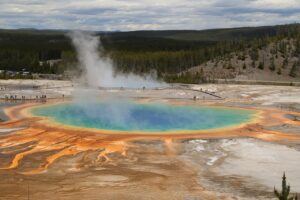Exploring Marine Life Habitats: A Dive into the Deep
Discovering the Diverse Marine Habitats of the World’s Oceans
The world’s oceans are teeming with diverse marine habitats, each providing a unique ecosystem for a wide variety of marine life. From the tropical waters of the Caribbean to the icy depths of the Arctic, these habitats support an incredible array of species.
Coral reefs, seagrass beds, mangrove forests, and rocky shores are just a few examples of marine habitats found around the world. Each of these habitats offers different conditions and resources, attracting a specific set of species that have adapted to thrive in their respective environments.
Exploring these habitats allows us to uncover the incredible biodiversity that exists beneath the surface of the ocean. By studying and understanding these habitats, we can gain valuable insights into the delicate balance of marine ecosystems and the importance of conserving these habitats for future generations.
Exploring the Enchanting Underwater Ecosystems
Underwater ecosystems are a mesmerizing world of beauty and wonder. From the colorful coral reefs to the vast kelp forests, these ecosystems are home to a wide range of marine life.
Coral reefs are often referred to as the rainforests of the ocean due to their high biodiversity. These vibrant and bustling ecosystems are made up of thousands of different species, including colorful fish, intricate coral formations, and fascinating invertebrates. They provide vital habitats for many marine species, acting as nurseries and feeding grounds.
Kelp forests, on the other hand, are found in colder waters and are dominated by large brown seaweeds known as kelp. These towering underwater forests provide shelter and food for a variety of species, including sea otters, fish, and invertebrates.
Exploring these enchanting underwater ecosystems allows us to witness the intricate relationships between different species and the crucial role they play in maintaining a healthy marine environment.
The Colorful Coral Reefs
Coral reefs are one of the most diverse and vibrant marine habitats on Earth. These underwater structures are formed by the accumulation of calcium carbonate secreted by corals.
The vibrant colors of coral reefs are a result of the symbiotic relationship between corals and tiny algae called zooxanthellae. These algae live within the coral polyps and provide them with energy through photosynthesis.
Coral reefs are home to a staggering variety of marine life, including fish, invertebrates, and even microorganisms. They provide shelter, breeding grounds, and feeding areas for countless species, making them an essential part of the ocean’s biodiversity.
However, coral reefs are facing numerous threats, including climate change, pollution, and overfishing. It is crucial to protect and conserve these delicate ecosystems to ensure the survival of the countless species that depend on them.
The Mysterious Deep Sea
The deep sea, also known as the abyssal zone, is one of the most mysterious and least explored habitats on Earth. This vast expanse of darkness and extreme pressure is home to a variety of unique and fascinating species.
Deep-sea habitats include underwater mountains known as seamounts, hydrothermal vents, and cold seeps. These environments provide specialized conditions and resources for deep-sea organisms to survive.
Many deep-sea creatures have developed extraordinary adaptations to thrive in this harsh environment. From bioluminescent fish that create their own light to giant squid with enormous eyes, the deep sea is full of surprises.
Exploring the mysterious deep sea allows scientists to uncover new species, study extreme adaptations, and gain a better understanding of the interconnectedness of all marine habitats.
The Vibrant Kelp Forests
Kelp forests are underwater ecosystems dominated by large brown seaweeds known as kelp. These towering underwater forests are found in colder waters and provide a unique habitat for a variety of marine life.
Kelp provides shelter, food, and a complex three-dimensional structure for a wide range of species. Sea otters, fish, sea urchins, and invertebrates are just a few examples of the diverse marine life that call kelp forests home.
These vibrant ecosystems are not only important for the species that rely on them but also for the surrounding coastal areas. Kelp forests help protect shorelines from erosion, absorb carbon dioxide, and provide a source of food for coastal communities.
However, kelp forests are facing threats such as climate change and pollution. Understanding the importance of these ecosystems and taking steps to conserve them is crucial for the health of our oceans.
The Bustling Coastal Estuaries
Coastal estuaries are dynamic and productive ecosystems where freshwater rivers meet the saltwater of the ocean. These transitional zones are rich in nutrients and provide a vital habitat for many species.
Estuaries serve as nurseries for juvenile fish, providing them with ample food and shelter. They also act as important feeding grounds for migratory birds and other marine animals.
These bustling ecosystems are home to a variety of species, including seagrasses, crabs, clams, and birds. The intertidal zones of estuaries are teeming with life, as organisms adapt to both the changing tides and the mix of saltwater and freshwater.
Coastal estuaries are not only important for the species that inhabit them but also for humans. They provide valuable ecosystem services, such as water filtration, flood control, and recreational opportunities.
However, estuaries are facing numerous threats, including pollution, coastal development, and climate change. Protecting and restoring these vital ecosystems is essential for the health of our coasts and the species that depend on them.
The Thriving Open Ocean
The open ocean, also known as the pelagic zone, is the vast expanse of water that stretches from the coastlines to the deep sea. It is a dynamic and ever-changing habitat that supports a wide range of marine life.
From tiny plankton to large migratory species like whales, the open ocean is home to a diverse array of organisms. These species have adapted to survive in different parts of the water column, from the surface waters to the deep abyss.
The open ocean plays a crucial role in regulating the Earth’s climate, absorbing carbon dioxide and producing oxygen through photosynthesis. It also serves as a vital source of food and resources for coastal communities around the world.
However, the open ocean is facing numerous challenges, including overfishing, plastic pollution, and climate change. Protecting this vast and vital habitat is essential for the health of our oceans and the sustainability of marine ecosystems.






